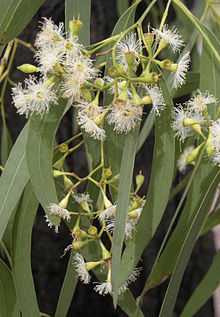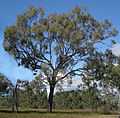Eucalyptus crebra
| Eucalyptus crebra | |
|---|---|
 | |
| Scientific classification | |
| Kingdom: | Plantae |
| (unranked): | Angiosperms |
| (unranked): | Eudicots |
| (unranked): | Rosids |
| Order: | Myrtales |
| Family: | Myrtaceae |
| Genus: | Eucalyptus |
| Species: | E. crebra |
| Binomial name | |
| Eucalyptus crebra F. Muell. | |
| Synonyms | |
|
Eucalyptus drepanophylla F.Muell. ex Benth. | |
Eucalyptus crebra, commonly known as the Narrow-leaved ironbark or Narrowleaf red ironbark, is a type of Ironbark tree native to eastern Australia. A member of the large genus Eucalyptus, this tree is in the Myrtaceae family and can grow to a large spreading tree up to 35 m (100 ft) high. It is an important source of nectar in the honey industry and its hard, strong timber is used in construction.
Taxonomy
The Narrow-leaved ironbark was originally described by Victoria state botanist Ferdinand von Mueller in 1859.[1] The specific epithet is the Latin adjective crebra "crowded" or "close together".[2] Within the genus Eucalyptus, it belongs in the subgenus Symphyomyrtus.
Description
This plant is a large spreading tree, which may reach 35 m (100 ft) in height. The rough furrowed bark is grey mottled with yellow and orange. The narrow lanceolate leaves are a uniform greyish-green in colour and measure 7–15 cm (2.8-6 in) in length by 0.9–1.7 cm (0.4-0.6 in) wide. The small white flowers appear from late autumn to spring, and are followed by small pods.[3]
Distribution and habitat
The Narrow-leaved ironbark is found in eastern Australia, from Picton southwest of Sydney north through New South Wales and Queensland to the vicinity of Cairns.[2] It grows on sandier soils.[4] The narrow-leaved ironbark is one of the key canopy species of the threatened Cumberland Plain Woodlands.[5]
Ecology
Koalas can consume the leaves, and the flowers are pollinated mainly by insects. The southern or shady side of the trunk is habitat for lichens.
Uses
The tree has a hard, strong, and dark red timber, which has been used for sleepers and construction.[2] A plank has been recorded as being used for Elizabeth Farm, Australia's oldest surviving European dwelling.[6] It is used as a shade tree or to line roadways, and is also available as a cultivar. It is useful in honey production as the flowers are heavy in nectar and pollen;[2] the resulting honey produced by bees is light-coloured and delicately flavoured.[7]
Gallery
-

E. crebra open capsules.
-

E. crebra open capsules.
-

E. crebra in coastal Central Queensland.
-

E. crebra bark
References
- ↑ "Eucalyptus crebra F.Muell.". Australian Plant Name Index (APNI), IBIS database. Centre for Plant Biodiversity Research, Australian Government.
- ↑ 2.0 2.1 2.2 2.3 Elliot, Rodger W. & Jones, David L. (1986). "Eu-Go". In Elliot, Rodger W. & Jones, David L. Encyclopaedia of Australian Plants suitable for cultivation 4. Lothian Publishing. pp. 66–67. ISBN 0-85091-213-X.
- ↑ Botanic Gardens Trust. "Eucalyptus crebra". Royal Botanic Gardens website. Royal Botanic Gardens, Sydney. Retrieved 2009-06-21.
- ↑ Hill, Ken (1999). "Eucalyptus crebra F.Muell.". PlantNet - New South Wales Flora Online. Royal Botanic Gardens & Domain Trust, Sydney Australia. Retrieved 2009-06-21.
- ↑ Department of Sustainability, Environment, Water, Population and Communities (20 June 2011). "Cumberland Plain Woodlands". Australian Government. Retrieved 7 September 2011.
- ↑ D'Hub (Design Hub). "D6911 Timber specimen (plank), Ironbark (Eucalyptus crebra), used in the building of stables at Elizabeth Farm, Rose Hill, New South Wales, Australia, 1793". D'hub - Your online design resource. Powerhouse Museum, Sydney. Retrieved 2009-06-24.
- ↑ Capilano Honey (2006). "Floral Varieties". Capilano Honey. Capilano Honey. Retrieved 2009-06-24.